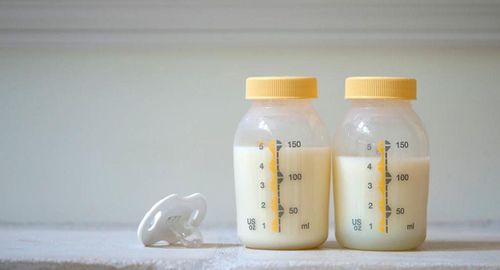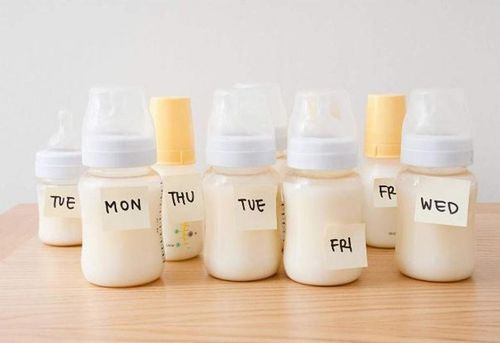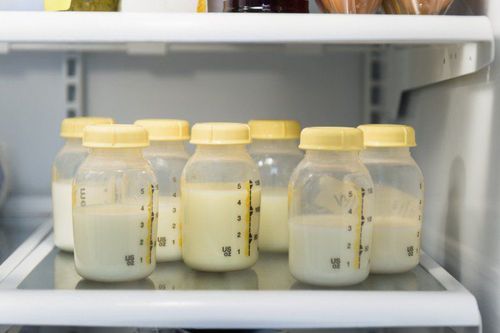This is an automatically translated article.
If you are breast-feeding or using a breast pump, you may have a lot of questions about these issues when your family goes on vacations away from home. This article will share with you some useful information when you fly and at the airport, how to store breast milk where you go, and how to bring it home safely.
1. How should you store breast milk while traveling?
When you're moving from one place to another, the best way to store breast milk is to store it in an airtight container, in a cooler or insulated cooler with an ice pack. For containers, many moms prefer to use pre-sterilized, sealable bags specifically designed to store breast milk. You can also use hard plastic or glass containers and make sure these are clean (wash in hot, soapy water, rinse thoroughly and let dry) and tightly covered.
Each box you should only keep from 60-100ml corresponding to one serving in a child's meal. If you plan to refrigerate, do not fill the container with milk, but leave a gap of about 2cm at the top. In the refrigerator with an ice pack, breast milk can be stored for 24 hours. You can breastfeed your baby the same day or the next day or when you arrive you can put it in the refrigerator or freezer for longer storage.
If you are not using the milk immediately, label the box with the date to track usage. Breast milk stays good for three to eight days in the refrigerator, six to 12 months if stored in the freezer, but can only be used for 4 to 6 hours at room temperature. (Note that if milk is frozen and thawed during travel, you need to use it within 24 hours, for safety reasons, you should put it back in the freezer.)
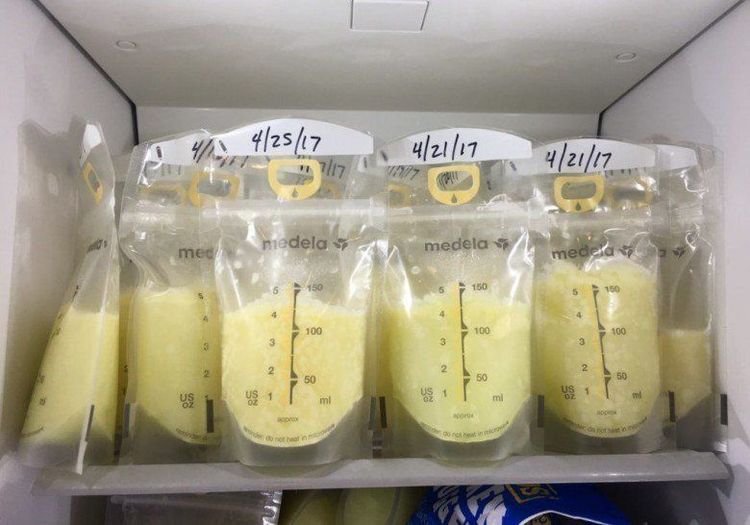
Sữa đông lạnh khi mang đi du lịch nên sử dụng trong vòng 4 tiếng đến 6 tiếng
2. Airport security issues when transporting breast milk
With changes in airport security limiting the amount of liquids that can be brought on board, many mothers are worried about flying when they have breast milk with them. Most expectant mothers wouldn't want to waste these precious bottles of their baby's milk.
In the past, when there were some aviation security regulations, some traveling mothers were forced to test the milk they brought with them by tasting or even spilling it all out at the security checkpoint. However, the Transportation Security Administration later pledged to reduce these troubles for mothers. Mothers can now bring breast milk in larger quantities than the legal limit for liquids on board. But make sure that when you go through security, you should keep your breast milk separate from other liquids and let the security staff know that you are carrying milk. They won't need to be stored in specialized containers like other liquids, but security officials may ask for a closer look. The total amount of breast milk that is allowed to be carried is yet to be determined, at the discretion of the security checker.
An easy way to avoid having to go through a breast milk test is to keep your carry-on milk in a small insulated cooler with an ice pack if you don't need it during the flight. The compartments in the plane are quite cool, so your breast milk will be well preserved during the flight.
If you plan to pump during the flight, you also need to learn some rules to ensure safety during the flight. In fact, breast pumps are considered a personal item and can be carried around like a laptop or purse in most airlines. But they will count as one of two carry-on items unless the size is small enough. You should call the airline in advance to confirm their policy on this.
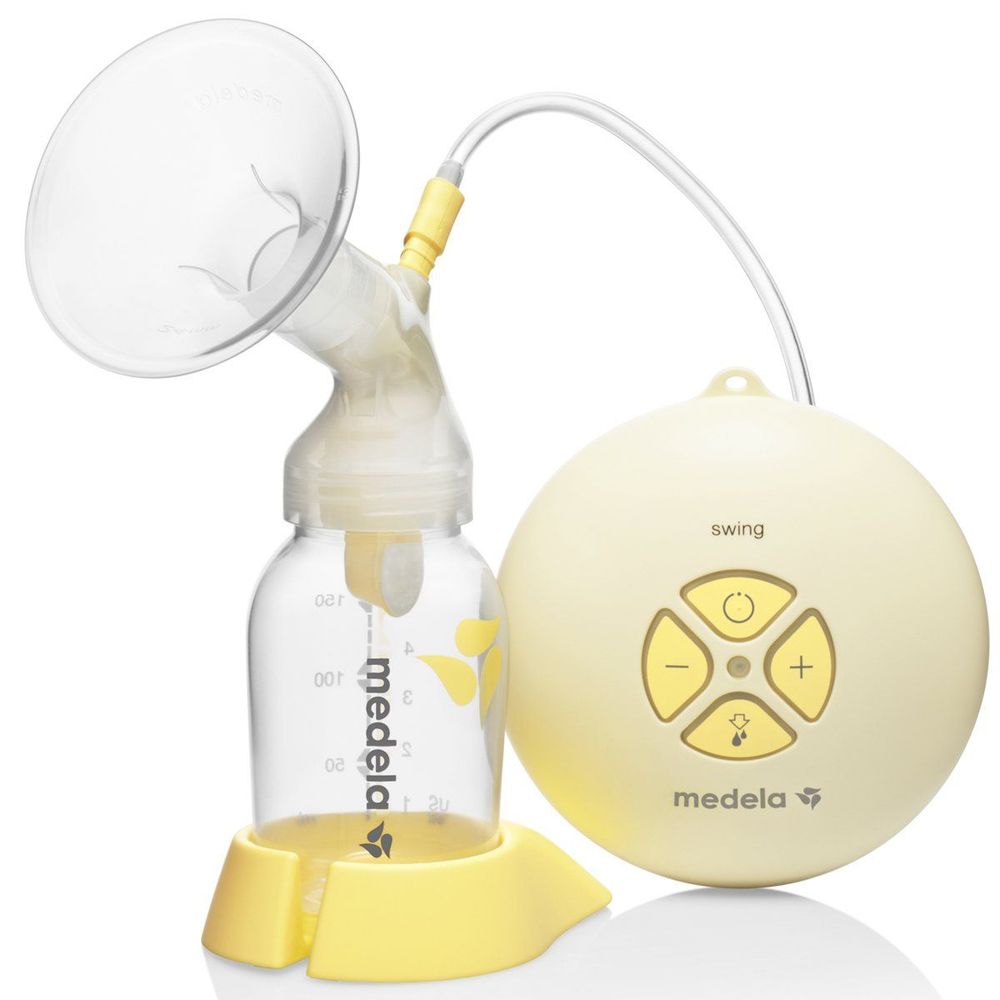
Máy hút sữa có thể được mang lên máy bay
3. Can you pump or breastfeed on the flight?
You may use a breast pump or breastfeed on your flight, but you may have to take special measures to ensure privacy. If a passenger complains of feeling uncomfortable, the flight attendant may ask you to cover your chest with a blanket, or they may reposition your seat. For extra reassurance, you can Check with your airline in advance to ask about their policy regarding breastfeeding and in-flight pumping. In fact, flight attendants can support and make you more comfortable, by letting you breastfeed or pump in the flight attendant area or helping you store breast milk in the on-board refrigerator. .
You can bring a small blanket, a light shawl or other similar product to cover your breasts when you are breastfeeding or pumping. You can also book a window seat, which will give you more space and privacy.
Another option is to breastfeed or pump in the airplane restroom. This suits some moms who prefer more privacy, but it is not a comfortable option and is not hygienic or pleasant.
If you plan to smoke or breastfeed in flight, keep in mind the best times to do so. If you're pumping, you may have to wait until the captain gives permission to use electronic devices after takeoff. If you're breastfeeding and traveling, you might consider breastfeeding during takeoff or landing to help relieve pressure in your baby's ears.
Note: The water on some planes contains coliform bacteria, so you should not use this water to clean pumping equipment or bottles. You can ask for bottled water if you need to clean your appliance.
Remember to wash your hands or use hand sanitizer before pumping or cleaning your pumping equipment, as planes and airports can expose you to a lot of germs.

Sử dụng máy hút sữa trên máy bay cần đảm bảo kín đáo
4. Can you pump or breastfeed at the airport?
Yes, you can pump or breastfeed at the airport, but it depends on the laws at that airport. In the United States, breastfeeding laws vary from state to state, and while some states explicitly protect a mother's right to breastfeed anywhere, others allow private businesses to Humans regulate the appropriateness of breastfeeding even in open areas such as shopping malls and airports.
If you are planning to travel abroad, you should read the breastfeeding laws in the place you are visiting or traveling. Marsha Walker, executive director of the National Alliance for Breastfeeding Advocacy, says there are no laws regarding breastfeeding in US airports. But she doesn't think mothers could have a problem doing so, because airports are so busy and packed with people that breastfeeding and pumping go unnoticed.
If you are going to a foreign airport, you should also find out some information before departure. Cultural attitudes towards breastfeeding vary by country and by culture.
When you arrive at your destination, you can ask at the information desk for a suitable place to pump or breastfeed. Airports often provide plenty of areas where you can pump or breastfeed discreetly. Finding a quiet corner to breastfeed can be challenging. However, some airports have family rooms that you can use. If you need to recharge your breast pump, you can usually find shops in the waiting area next to the gate.
5. How should you store breast milk after visiting a tourist destination?
The easiest way to store milk is to put it in the fridge when you get there. If you stay in a hotel, use the in-room mini-fridge. (If your room doesn't have a mini-fridge, many hotels will provide one if you request it, although they may charge an extra fee)
Set the refrigerator to the coldest setting that is actually cold enough. Some types have a freezer compartment in the refrigerator, you can use them to freeze milk, convenient for transporting milk or sending milk home.
Some hotels will even store your milk in the hotel's own refrigerator or freezer. Some hotels will have a free milk storage service if you ask for it.

Ngay khi đến địa điểm du lịch, mẹ nên bảo quản sữa trong tủ lạnh
6. How do you transport breast milk home?
If you are away for a long time on business, you may want to send breast milk home for your baby or keep it in the freezer at home. While it can be more difficult and expensive than bringing your own milk home, it's completely doable.
If you can freeze breast milk at your location, you can ship the frozen milk home in an insulated container with an ice pack. If the milk is frozen, it can be stored in the freezer for long-term use. However, if the milk has been thawed, it should not be frozen and should be used within 24 hours.
If you can't freeze milk before shipping home, try using dry ice to keep it cold during shipping. Dry ice can be difficult to find, you can call ahead to find a store that sells dry ice. This is a useful option to help you transport milk home.
Breast milk is an invaluable source of nutrition that no other milk can match. Breastfeeding is not only good for the baby, but also improves the health of the mother. Therefore, if mothers have difficulties in breastfeeding as well as how to preserve them, mothers can go to Vinmec International General Hospital for advice from qualified doctors.
Please dial HOTLINE for more information or register for an appointment HERE. Download MyVinmec app to make appointments faster and to manage your bookings easily.
Reference source: babycenter.com





